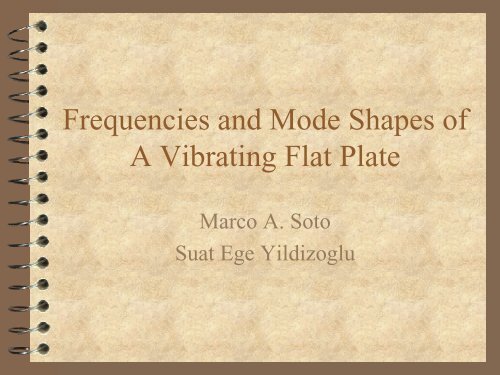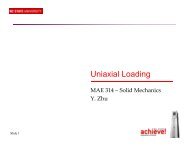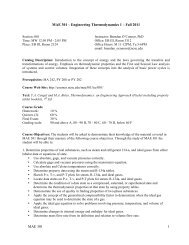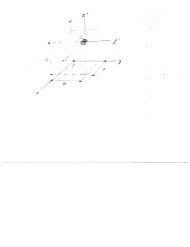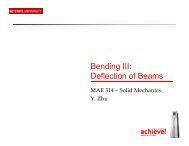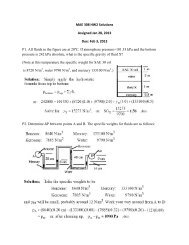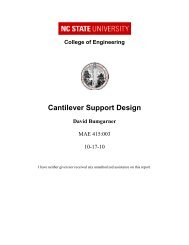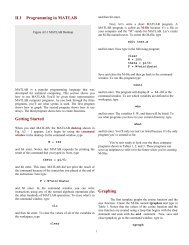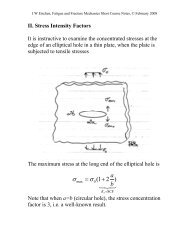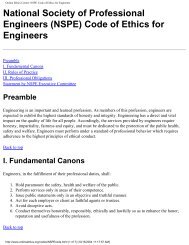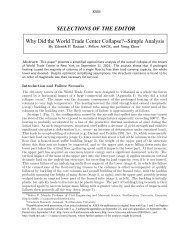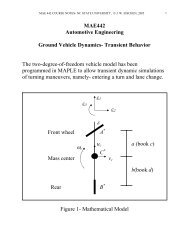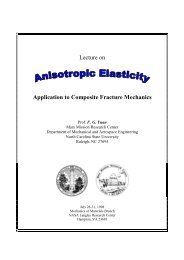Frequencies and Mode Shapes of A Vibrating Flat Plate
Frequencies and Mode Shapes of A Vibrating Flat Plate
Frequencies and Mode Shapes of A Vibrating Flat Plate
You also want an ePaper? Increase the reach of your titles
YUMPU automatically turns print PDFs into web optimized ePapers that Google loves.
<strong>Frequencies</strong> <strong>and</strong> <strong>Mode</strong> <strong>Shapes</strong> <strong>of</strong><br />
A <strong>Vibrating</strong> <strong>Flat</strong> <strong>Plate</strong><br />
Marco A. Soto<br />
Suat Ege Yildizoglu
Motivation<br />
�In Space, no one can hear you scream about<br />
how little damping there is.<br />
�Dynamic <strong>Mode</strong>ls <strong>of</strong> Flexible Systems are<br />
necessary, but Analytical Solutions are<br />
Large.<br />
�Finite Element Solutions Usually Yield<br />
Comparable Results
<strong>Mode</strong>ling<br />
�Round 1: Kirch<strong>of</strong>f Versus Mindlin<br />
�Round 2: Shell Versus Brick<br />
�Round 3: Boundary Condition Battle<br />
Royale
Assumptions (Kirch<strong>of</strong>f)<br />
�Deflections are small compared to thickness<br />
�No transverse normal stresses<br />
�The middle plane <strong>of</strong> the plate is a neutral<br />
plane<br />
�Straight lines normal to middle plane<br />
remain normal after bending.
“Analytical” Solution<br />
�Separation <strong>of</strong> Time-Dependant <strong>and</strong> Spatial-<br />
Dependant Variables.<br />
�For natural frequencies, the Eigenvalue<br />
problem is solved for Spatial Dimensions.<br />
�This involves the boundary conditions, <strong>and</strong><br />
geometric <strong>and</strong> material properties.
<strong>Plate</strong> Properties<br />
�<strong>Plate</strong> is 1 meter long by 1 meter wide<br />
�<strong>Plate</strong> Thickness <strong>of</strong> 0.01 meters<br />
�Material Properties for Aluminum <strong>Plate</strong>:<br />
�Young’s Modulus=73.1 Gpa<br />
�Mass Density= 2770 kg/m 3<br />
�Poission’s Ratio=0.33
MATLAB Results<br />
� First <strong>Mode</strong> Shape<br />
� Natural Frequency<br />
= 49.353 Hz<br />
� Maximum Deflection<br />
=0.3800 m
MATLAB Results<br />
� Second <strong>Mode</strong> Results<br />
� Natural Frequency<br />
= 123.383 Hz<br />
� Maximum Deflection<br />
= 0.3800 m
ANSYS Results<br />
� First <strong>Mode</strong> Results<br />
� Natural Frequency =<br />
49.209 Hz<br />
� Maximum Deflection<br />
=0.380052m
ANSYS Results<br />
� Second <strong>Mode</strong> Results<br />
� Natural Frequency<br />
=122.752 Hz<br />
� Maximum Deflection<br />
=0.3201m
Conclusions<br />
�FEA <strong>Mode</strong>ling <strong>of</strong> Vibration Problems is<br />
Simple <strong>and</strong> Accurate<br />
�Ansys is a good tool for visualization <strong>of</strong><br />
vibration modes <strong>and</strong> eigenvalue extraction.


